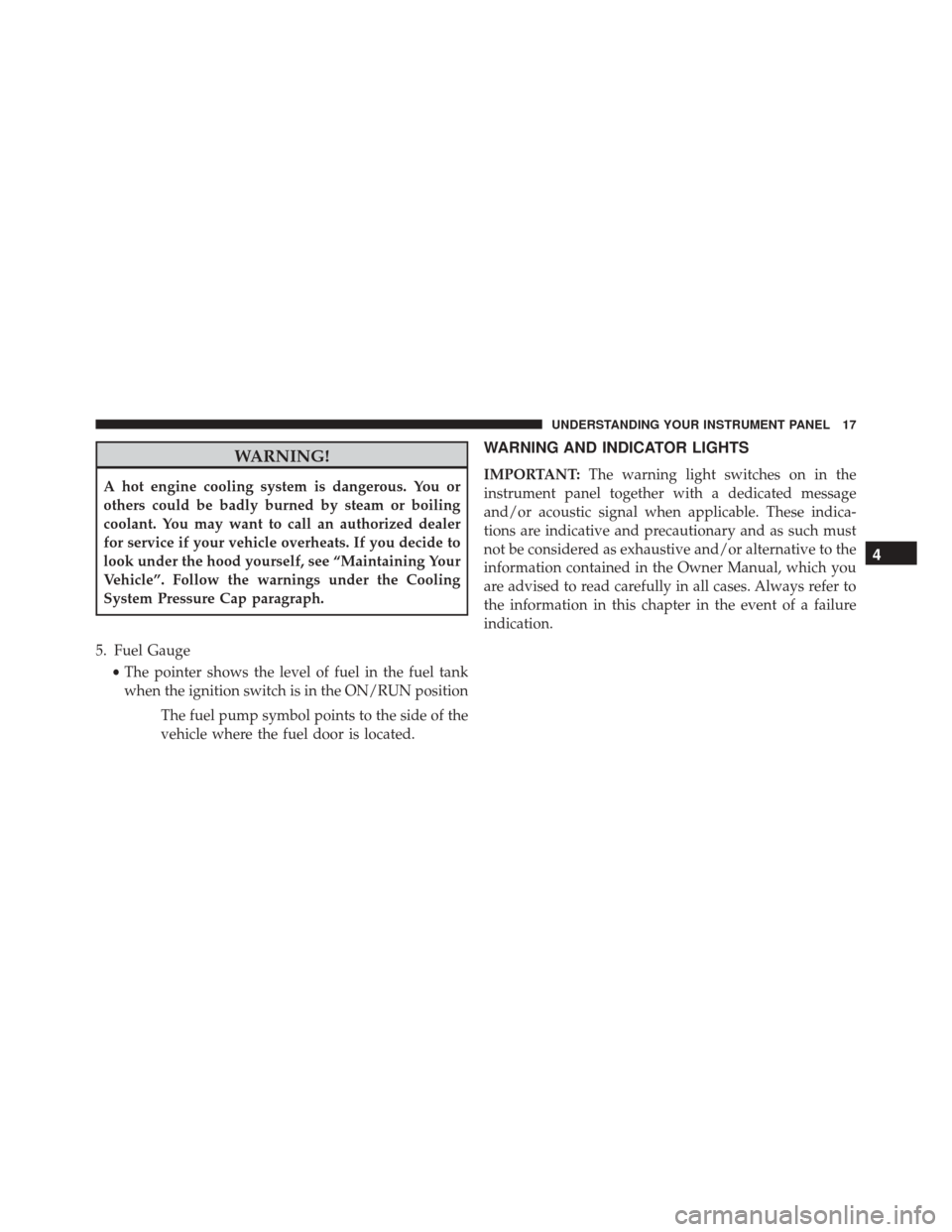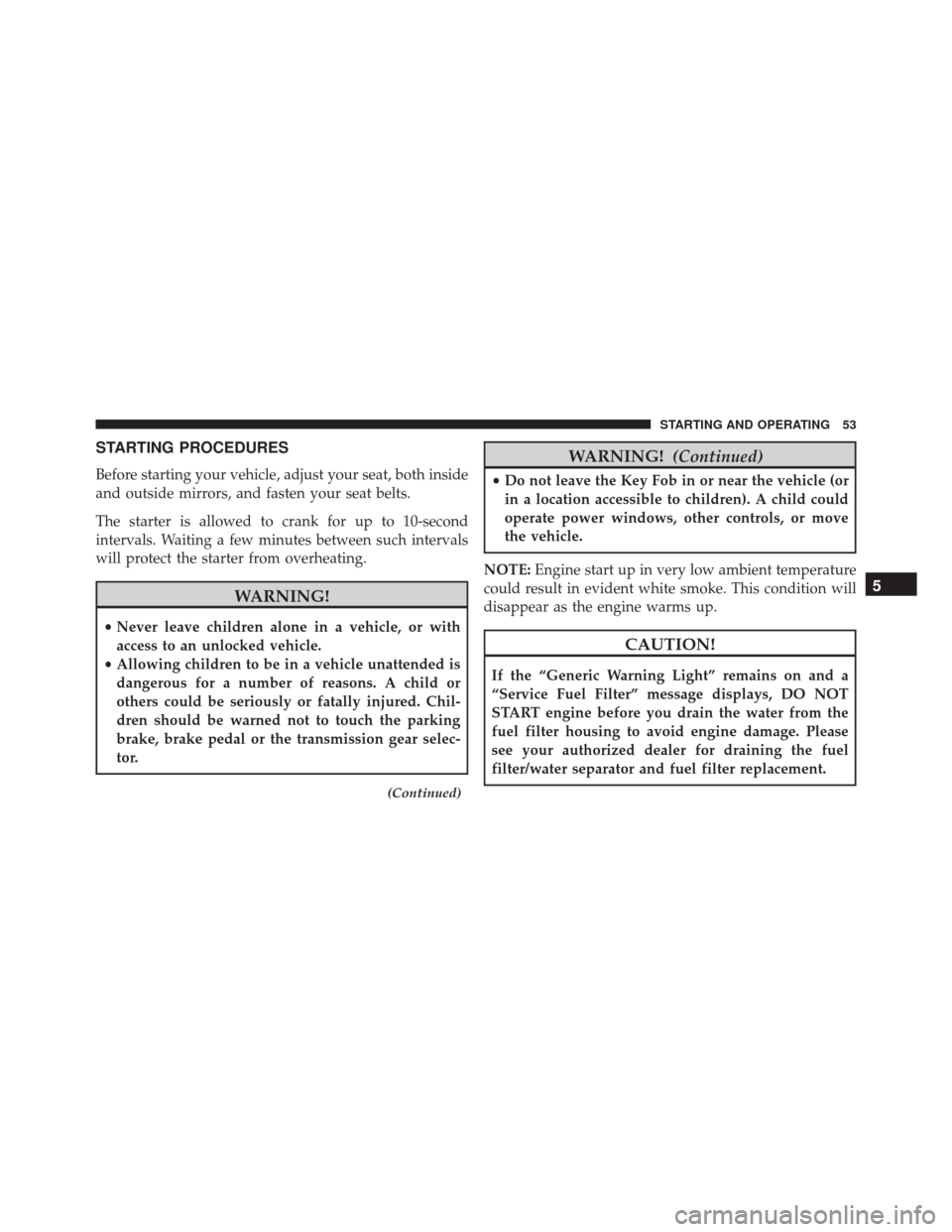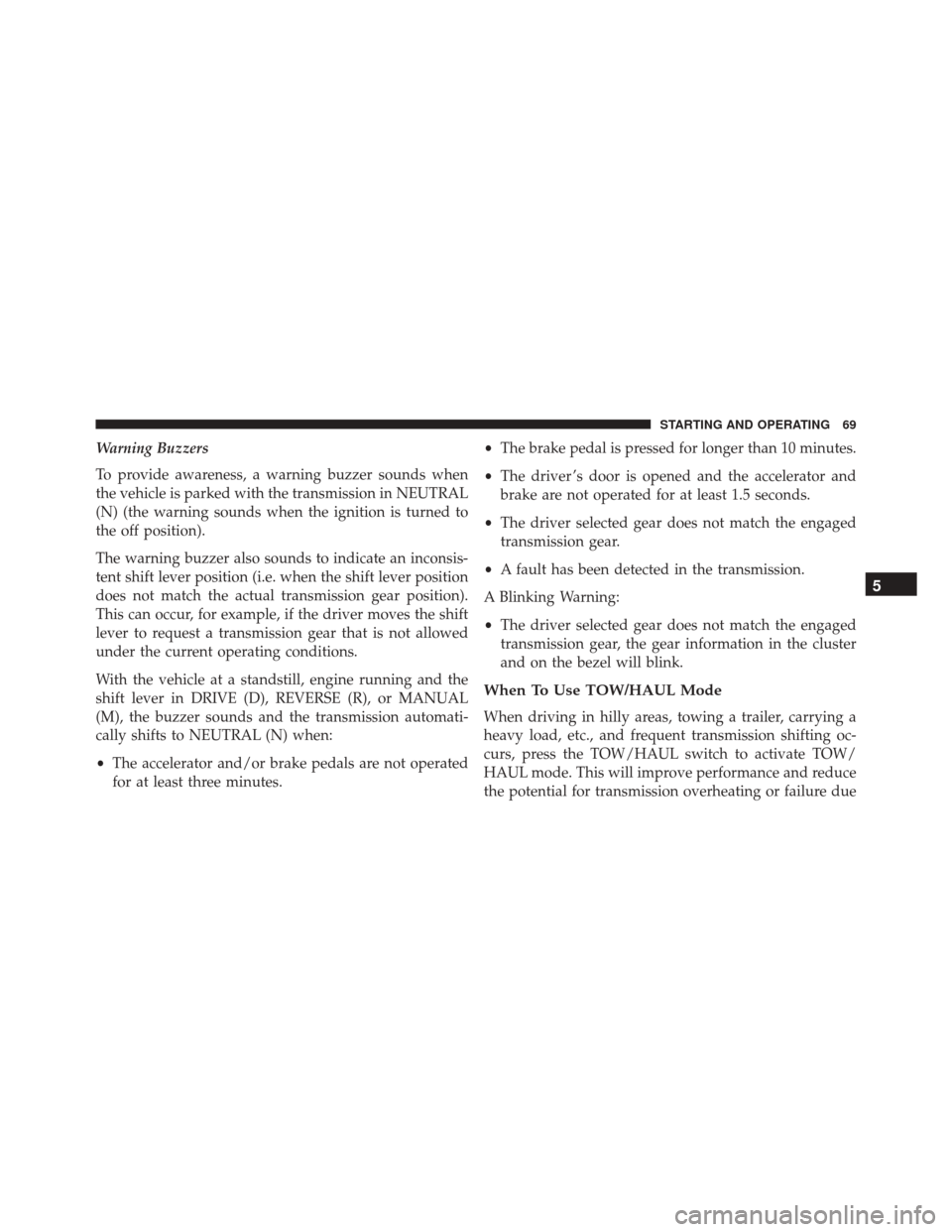Page 19 of 145

WARNING!
A hot engine cooling system is dangerous. You or
others could be badly burned by steam or boiling
coolant. You may want to call an authorized dealer
for service if your vehicle overheats. If you decide to
look under the hood yourself, see “Maintaining Your
Vehicle”. Follow the warnings under the Cooling
System Pressure Cap paragraph.
5. Fuel Gauge •The pointer shows the level of fuel in the fuel tank
when the ignition switch is in the ON/RUN position
The fuel pump symbol points to the side of the
vehicle where the fuel door is located.
WARNING AND INDICATOR LIGHTS
IMPORTANT: The warning light switches on in the
instrument panel together with a dedicated message
and/or acoustic signal when applicable. These indica-
tions are indicative and precautionary and as such must
not be considered as exhaustive and/or alternative to the
information contained in the Owner Manual, which you
are advised to read carefully in all cases. Always refer to
the information in this chapter in the event of a failure
indication.
4
UNDERSTANDING YOUR INSTRUMENT PANEL 17
Page 24 of 145
Engine Temperature Warning Light
Red TelltaleLight What It Means
Engine Temperature Warning Light
This light warns of an overheated engine condition. If the engine coolant temperature is too
high, this indicator will illuminate and a single chime will sound.
If the light turns on while driving, safely pull over and stop the vehicle. If the A/C system is on,
turn it off. Also, shift the transmission into NEUTRAL and idle the vehicle. If the temperature
reading does not return to normal, turn the engine off immediately and call for service. Refer to
“If Your Engine Overheats” in “What To Do In Emergencies” for further information.
For vehicles equipped with a premium cluster, this indicator will display in the DID. Refer to
”Driver Information Display (DID) — If Equipped” for further information.
22 UNDERSTANDING YOUR INSTRUMENT PANEL
Page 27 of 145
Coolant Temperature Warning Light
Red TelltaleLight What It Means
Coolant Temperature Warning Light
This light warns of an overheated engine condition. If the light turns on while driving,
safely pull over and stop the vehicle. If the A/C system is on, turn it off. Also, shift the
transmission into NEUTRAL and idle the vehicle. If the temperature reading does not return
to normal, turn the engine off immediately and call for service.
NOTE:
As the coolant temperature gauge approaches
�H,�this indicator will illuminate and a single
chime will sound. Further overheating will cause the temperature gauge to pass �H.�In this
case, a continuous chime will sound until the engine is allowed to cool or the 4 minutes du-
ration is expired, whichever come first.
4
UNDERSTANDING YOUR INSTRUMENT PANEL 25
Page 55 of 145

STARTING PROCEDURES
Before starting your vehicle, adjust your seat, both inside
and outside mirrors, and fasten your seat belts.
The starter is allowed to crank for up to 10-second
intervals. Waiting a few minutes between such intervals
will protect the starter from overheating.
WARNING!
•Never leave children alone in a vehicle, or with
access to an unlocked vehicle.
• Allowing children to be in a vehicle unattended is
dangerous for a number of reasons. A child or
others could be seriously or fatally injured. Chil-
dren should be warned not to touch the parking
brake, brake pedal or the transmission gear selec-
tor.
(Continued)
WARNING! (Continued)
•Do not leave the Key Fob in or near the vehicle (or
in a location accessible to children). A child could
operate power windows, other controls, or move
the vehicle.
NOTE: Engine start up in very low ambient temperature
could result in evident white smoke. This condition will
disappear as the engine warms up.
CAUTION!
If the “Generic Warning Light” remains on and a
“Service Fuel Filter” message displays, DO NOT
START engine before you drain the water from the
fuel filter housing to avoid engine damage. Please
see your authorized dealer for draining the fuel
filter/water separator and fuel filter replacement.
5
STARTING AND OPERATING 53
Page 71 of 145

Warning Buzzers
To provide awareness, a warning buzzer sounds when
the vehicle is parked with the transmission in NEUTRAL
(N) (the warning sounds when the ignition is turned to
the off position).
The warning buzzer also sounds to indicate an inconsis-
tent shift lever position (i.e. when the shift lever position
does not match the actual transmission gear position).
This can occur, for example, if the driver moves the shift
lever to request a transmission gear that is not allowed
under the current operating conditions.
With the vehicle at a standstill, engine running and the
shift lever in DRIVE (D), REVERSE (R), or MANUAL
(M), the buzzer sounds and the transmission automati-
cally shifts to NEUTRAL (N) when:
•The accelerator and/or brake pedals are not operated
for at least three minutes. •
The brake pedal is pressed for longer than 10 minutes.
• The driver ’s door is opened and the accelerator and
brake are not operated for at least 1.5 seconds.
• The driver selected gear does not match the engaged
transmission gear.
• A fault has been detected in the transmission.
A Blinking Warning:
• The driver selected gear does not match the engaged
transmission gear, the gear information in the cluster
and on the bezel will blink.
When To Use TOW/HAUL Mode
When driving in hilly areas, towing a trailer, carrying a
heavy load, etc., and frequent transmission shifting oc-
curs, press the TOW/HAUL switch to activate TOW/
HAUL mode. This will improve performance and reduce
the potential for transmission overheating or failure due
5
STARTING AND OPERATING 69
Page 73 of 145

•To avoid accelerated clutch wear, do not use the
accelerator to keep the vehicle at a standstill (for
example, holding on a hill); the clutch could be dam-
aged by overheating. Use the brake pedal instead and
operate the accelerator only when you are ready to
drive away.
• Only launch (from a stop) in second gear when you
need more control on surfaces with low traction.
• Only shift between DRIVE (D) and REVERSE (R) gears
when the vehicle has come to a stop and the brake
pedal is pressed. •
Although very inadvisable, if the vehicle is unexpect-
edly allowed to roll downhill with the gearbox in
NEUTRAL (N) the system will automatically engage
the gear best suited to vehicle speed when a gear shift
is requested to allow drive to be correctly transmitted
to the wheels.
• If necessary, with the engine off, it is possible to engage
1st, REVERSE (R) or NEUTRAL (N) with the key in
ON/RUN/MAR position and the brake pressed.
• During hill starts, accelerate immediately after releas-
ing the parking brake or brake pedal to allow the
engine to increase its rpm to a greater extent and
overcome higher gradients with more torque.
5
STARTING AND OPERATING 71
Page 75 of 145

MESSAGEDESCRIPTION
Manual Unavailable MANUAL (M) mode is not available, due to a fault or other condi-
tion. Use the DRIVE (D) position to operate the vehicle.
Contact your authorized dealer if the message continues to appear.
Automatic Unavailable Automatic (DRIVE) mode is not available due to a fault or other con-
dition. Use MANUAL (M) mode to operate the vehicle.
Contact your authorized dealer if the message continues to appear.
Transmission Temperature High This message appears, together with a buzzer, when the clutch over- heats.
In this situation, limit stop and go driving and gear shifts or if neces- sary stop the vehicle and turn the engine off to allow the clutch to cool.
If the message continues to appear, contact your Authorized Dealer. To avoid clutch malfunction, do not use the accelerator to keep the
vehicle at a standstill (for example holding on a hill); the clutch could be damaged by overheating. Use the brake pedal instead and operate the accelerator only when you are ready to drive away.
5
STARTING AND OPERATING 73
Page 101 of 145
Tow/Haul Mode
To reduce the potential for transmission overheating,
activate the “TOW/HAUL” feature when using DRIVE
(D) (automatic mode) in hilly areas.
Electronic Speed Control — If Equipped
•Do not use in hilly terrain or with heavy loads.
• When using the speed control, if you experience speed
drops greater than 10 mph (16 km/h), disengage until
you can get back to cruising speed.
• Use speed control in flat terrain and with light loads to
maximize fuel efficiency.
Cooling System
To reduce potential for engine and transmission over-
heating, take the following actions:
City Driving
When stopped for short periods, shift the transmission
into NEUTRAL and increase engine idle speed.
Highway Driving
Reduce speed.
Air Conditioning
Turn off temporarily.
5
STARTING AND OPERATING 99